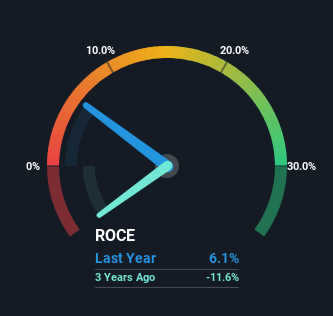Sapmer's (EPA:ALMER) Returns On Capital Not Reflecting Well On The Business

What underlying fundamental trends can indicate that a company might be in decline? When we see a declining return on capital employed (ROCE) in conjunction with a declining base of capital employed, that's often how a mature business shows signs of aging. Ultimately this means that the company is earning less per dollar invested and on top of that, it's shrinking its base of capital employed. On that note, looking into Sapmer (EPA:ALMER), we weren't too upbeat about how things were going.
Understanding Return On Capital Employed (ROCE)
For those who don't know, ROCE is a measure of a company's yearly pre-tax profit (its return), relative to the capital employed in the business. Analysts use this formula to calculate it for Sapmer:
Return on Capital Employed = Earnings Before Interest and Tax (EBIT) ÷ (Total Assets - Current Liabilities)
0.061 = €4.3m ÷ (€147m - €76m) (Based on the trailing twelve months to December 2023).
Therefore, Sapmer has an ROCE of 6.1%. Ultimately, that's a low return and it under-performs the Food industry average of 8.6%.
See our latest analysis for Sapmer

Historical performance is a great place to start when researching a stock so above you can see the gauge for Sapmer's ROCE against it's prior returns. If you want to delve into the historical earnings , check out these free graphs detailing revenue and cash flow performance of Sapmer.
The Trend Of ROCE
The trend of ROCE at Sapmer is showing some signs of weakness. The company used to generate 10% on its capital five years ago but it has since fallen noticeably. In addition to that, Sapmer is now employing 54% less capital than it was five years ago. The combination of lower ROCE and less capital employed can indicate that a business is likely to be facing some competitive headwinds or seeing an erosion to its moat. Typically businesses that exhibit these characteristics aren't the ones that tend to multiply over the long term, because statistically speaking, they've already gone through the growth phase of their life cycle.
While on the subject, we noticed that the ratio of current liabilities to total assets has risen to 52%, which has impacted the ROCE. Without this increase, it's likely that ROCE would be even lower than 6.1%. And with current liabilities at these levels, suppliers or short-term creditors are effectively funding a large part of the business, which can introduce some risks.
Our Take On Sapmer's ROCE
In summary, it's unfortunate that Sapmer is shrinking its capital base and also generating lower returns. Investors haven't taken kindly to these developments, since the stock has declined 59% from where it was five years ago. With underlying trends that aren't great in these areas, we'd consider looking elsewhere.
Sapmer does come with some risks though, we found 4 warning signs in our investment analysis, and 2 of those are significant...
For those who like to invest in solid companies, check out this free list of companies with solid balance sheets and high returns on equity.
New: Manage All Your Stock Portfolios in One Place
We've created the ultimate portfolio companion for stock investors, and it's free.
• Connect an unlimited number of Portfolios and see your total in one currency
• Be alerted to new Warning Signs or Risks via email or mobile
• Track the Fair Value of your stocks
Have feedback on this article? Concerned about the content? Get in touch with us directly. Alternatively, email editorial-team (at) simplywallst.com.
This article by Simply Wall St is general in nature. We provide commentary based on historical data and analyst forecasts only using an unbiased methodology and our articles are not intended to be financial advice. It does not constitute a recommendation to buy or sell any stock, and does not take account of your objectives, or your financial situation. We aim to bring you long-term focused analysis driven by fundamental data. Note that our analysis may not factor in the latest price-sensitive company announcements or qualitative material. Simply Wall St has no position in any stocks mentioned.
About ENXTPA:ALMER
Sapmer
Operates as a fishing company in South Africa, Northern America, Mauritius, Japan, Europe, China, and Réunion Island.
Slight with mediocre balance sheet.


